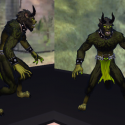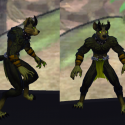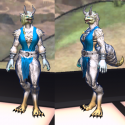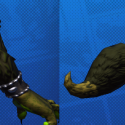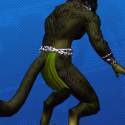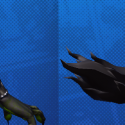-
Here you will find the three breeds of wargkesh that exist, the features they all posses, as well as the features each breed differs on.
-
General Physical Traits

Eyes: Vibrant, softly glowing colors. "Cool" colors like cyan/turquoise, blue and purple are rare, with yellow, green, red, and orange being the most common shades. Battle and hunting wargkesh have cat-like, slitted pupils, and riding wargkesh have round pupils. Their paw pads, nipples, and genitals always match their eye color. In lighting considered normal for most above-ground creatures, their pupils constrict to veritable pin-pricks and vision becomes poorer the brighter it becomes. A sunny day would be physically painful to a wargkesh not accustomed to above-ground lighting.
Fur: Primary, secondary, and tertiary colors in markings, underbellies, inner ears, face, etc. can be any color naturally occurring in wolves - anywhere from black to white, as well as "earthy" tones such as brown, cinnamon, beige, olive, and even mossy, brownish-green.
Markings: Owing to their demonic heritage, bat-wing-like markings across their shoulders and skull-like markings on their faces are not uncommon, but less unnatural markings also show up thanks to their wolf heritage. It isn't uncommon for them to dye streaks into their fur or tattoo their skin with tribal ranking marks to match their eyes/paw pads. Other markings possible are hyena-like spots and stripes, and leopard-like rosettes.
Fangs: All adult wargkesh have saber-tooth tiger-like fangs. They are not visible past their lips until puberty.
Noses, Tongues, and Gums: Almost always black, but can also be the color of their eyes/paw pads. This is, however, considered rare and not ideal, as it makes them stick out from their kin.
Horns: Ram-like horns with ridges that can curl inward in youth, but begin to curl backwards as they grow. They are dense (not hollow - made of solid bone) and have an enamel coating (much like teeth). They can have any color that metals commonly come in: silver, black, copper, gold, etc. Rarer metals are not unheard of, but are, like their elemental counterparts, much more rare. Culturally, the larger and sharper the horns are, the more likely the individual is to attract a mate.
Claws: Their nails/claws are always the same color as their horns and also have an enamel coating. Only riding wargkesh cannot retract the claws, while hunting and battle wargkesh can freely sheath and unsheath them.
Eyebrow Spikes: All adult wargkesh have two-to-three spikes sprouting from their brows. They are considered defensive (as they protect the eyes when attacked) and also ornamental. The larger and sharper the brow-spikes (along with their horns) are, the more likely the individual is to gain a mate.
Blood: Their blood causes any that ingest it to become violently ill unless they have a very high fortitude. It is a sticky, black, ichor-like substance and highly acidic.
Sexes: Wargkesh come in three sexes, though male and female are most common. The third, intersex, is rare, yet far more common than in humans. Genders are far more complex. See 'Sex/Gender' under 'Culture & History.
Genitals: Human-like. Male wargkesh are born with external penises sheathed in a foreskin and testicles that hang between their legs, not a dog-like sheathe. Females have outer-labia that almost completely conceal their inner labia and clitoris. Intersex wargkesh can have any variation of the two.
Lifespan:Wargkesh can live up to 150 years, though most do not live longer than 115. They reach sexual maturity at 25, and are considered young-adults until 35. They are considered 'elders' at 80, and 'high-elders' at 100.
Reproduction: The average gestation of wargkesh is 7 months. Wargkesh known to be carrying cubs are not allowed to hunt, fight, or transform (as transforming would be extremely dangerous for both the cubs and their parent) but other duties in higher roles are expected to be taken care of up until the birth of the cubs. Wargkesh that breed with non-wargkesh will only produce wargkesh cubs. The only genetic information passed down by the non-wargkesh parent will be things like eye and skin/fur color as well as markings, within reason. There will be no wargkesh with unnatural main coat colors, but for hybrids only, secondary fur colors like markings may be tinted unnaturally. Again - within reason. There will be no sparkle-wargs, sorry. Your wargkesh can and should dye their fur/hair and tattoo their skin in any color they choose, but usually it will match their eye color.
-
Breeds

(An intersex battle wargkesh with tufted tail and seal-like nose)
As the wargkesh species developed via selective breeding, the orks separated them into specific "types" for different jobs in the horde. Wargkesh can appear more feline or canine depending on the breed, and have varying traits, skill-sets and active schedules.
In general, female and intersex wargkesh are usually slightly taller and much heavier thanks to more muscle and fat mass. This is because it is the wargkesh doing the carrying of pups fights for their mate, whether it be a female or intersex wargkesh. The heights and weights listed here are averages, so it is not unheard of for wargkesh to be taller/shorter or heavier/lighter than these numbers.
- BATTLE Wargkesh
- Face Structure: Bearish/wolfish features
- Eyes: Slitted pupils
- Claws: Retractable
- Ears: Small, pointed
- Average Heights and Weights
- Bipedal/Anthro Height:
- Males: 6'6"-6'10"
- Females: 6'7"-7'2"
- Intersex: 6'6"-7'2"
- Bipedal/Anthro Weight:
- Males: 275-375 lbs.
- Females: 285-400 lbs.
- Intersex: 285-400 lbs.
- Quadrupedal/Feral Height:
- Males: 4'-5' at hunch, 9'4" on hind legs
- Females: 4'6"-5'7" at hunch, 10' on hind legs
- Intersex: 4'6"-5'7" at hunch, 10' on hind legs
- Quadrupedal/Feral Weight:
- Males: 300-600 lbs.
- Females: 375-750 lbs.
- Intersex: 375-750 lbs.
- Orkish Form Height:
- Males: 6'6"-6'10"
- Females: 6'8"-7'
- Intersex: 6'8"-7'
- Orkish Form Weight:
- Males: 200-325 lbs.
- Females: 250-375 lbs.
- Intersex: 250-375 lbs.
- Bipedal/Anthro Height:
- Body: Short-bodied, stocky frames. Built like bears crossed with bulls - most of their muscle is in their thick front limbs, hunched shoulders, and neck.
- Tail: Either long and fluffy, or short and tufted (like a bob-tailed Vallhund). The short, tufted tails are considered more desirable as long tails are a weak spot in battle.
- Nose: Mid-range between dog-like and feline-like. Can appear more akin to seal
- Activity Schedule: Can be nocturnal (mainly active at night), crepuscular (active during dawn and dusk) or, rarely, diurnal (active during the day). It depends on the individual or their master's needs.
- Purpose/Skill-Set: Bred purely as front-line skirmishers and pit-fighters. Of the wargkesh, they are somewhat sociable, but are difficult to train as they favor tough, strong masters and are extremely willful and instinct-driven.
- HUNTING Wargkesh
- Face Structure: Big-cat (feline) features
- Eyes: Slitted pupils
- Claws: Retractable
- Ears: Small, triangular, cat-like OR round, tiger-like ears
- Body: Long-bodied, lithe frames (at least in comparison to the other breeds).
- Tail: Long, snow-leopard-like
- Nose: Thin, wide
- Activity Schedule: Almost entirely nocturnal
- Purpose/Skill-Set: They hunt in packs for food and other resources. Of the wargkesh, they are the most sociable and easiest to train.
- RIDING Wargkesh
- Face Structure: More canine (African WIld Dog/hyena like features)
- Eyes: Circular pupils
- Claws: Non-retractable
- Ears: Large, pointed
- Body: Short-bodied frames with long limbs
- Tail: Wolfish plumed tails, or German Shepherd-like tails
- Nose: Large, round
- Activity Schedule: Almost always crepuscular
- Purpose/Skill-Set: They were bred by orks for riding across the plains, scouting for stragglers, carrying messengers and so on. They are also ridden into battle as the cavalry, but are generally not front-line battalions. They are relatively easy to train, but are willful and spirited, and require a stern hand.
- BATTLE Wargkesh
-
Gallery


